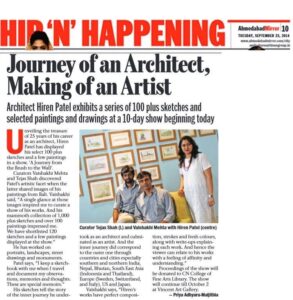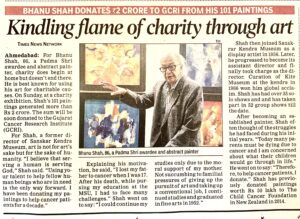“Nadi Ni Ret Ma Ramtu Nagar Male Na Male, Fari Smrutipat par aa chitra male na male…”(Town – that is sportingly growing up on river bed is perpetually changing, We never know whether we will be able to ever in future again be able to see its rare glimpses) —words of ghazal by Adil Mansuri – poet, native of Ahmedabad and textile business professional aptly and artistically manifest peculiarities of the city in keeping with the strict meter of Ghazal.
And this is just one example of such various classic to contemporary ghazals sprinkled with flavour of Ahmedbad city, Gujarati language and literary heritage were poetically rendered by poet Tushar Shukla and litterateur Darshan Jariwalla at the concluding session of the first day of Ahmedabad International Arts Festival.
Tushar Shukla, poet, said, “From the primary four stages of the history of Gujarati Ghazal form, we have selected a few classics and contemporaries who have conformed to a pattern, some who have broke the pattern to re-create something novel. We have explored the form meticulously and poetically.”
Amidts celebration of the multi disciplinary convergence of art forms at AIAF, exploration of patterns in literary form of Gujarati Ghazal was a scholastic session. Within short span of two-hours, with a brief talk on history of Ghazal form by Hardwar Goswami, educationist and poet, ghazals by classics including Kalapi, Balashankar Kantharia, Gani’, ‘Mariz’, ‘Befam’, ‘Ghayal’, ‘Shunya’, Adil Mansuri
– names that have created history and have de-constructed this foreign genre only to re-create fresh patterns having local flavours – were included in the readings. The creations of senior contemporary poets Rajendra Shukla, Ramesh Parekh, Chinu Modi and Manoj Khanderia – (whose verse Pakdo to kalam to kyarek ….Em Pan Bane gave befitting title to the program) – were also rendered.
Darshan Jariwalla, actor, who also writes ghazals, said, “Gujarati ghazal has its own identity. From era of nascent Sufism, it matured to the level of extending its basic dual-line form to Tripadi (poems of Ramesh Parekh, Hemen Shah) and contemporary poets (e g Rajendra Shukla) could enrich the form with Sanskrit-Prakrit influences by inclusion of specialised meters like Shikharini, Mandakranta and Shardul Vikridit. Organised poetic rendition of poems by torch bearers that formed the history of Gujarati ghazals is a way to document the patterns of this art-form.”

